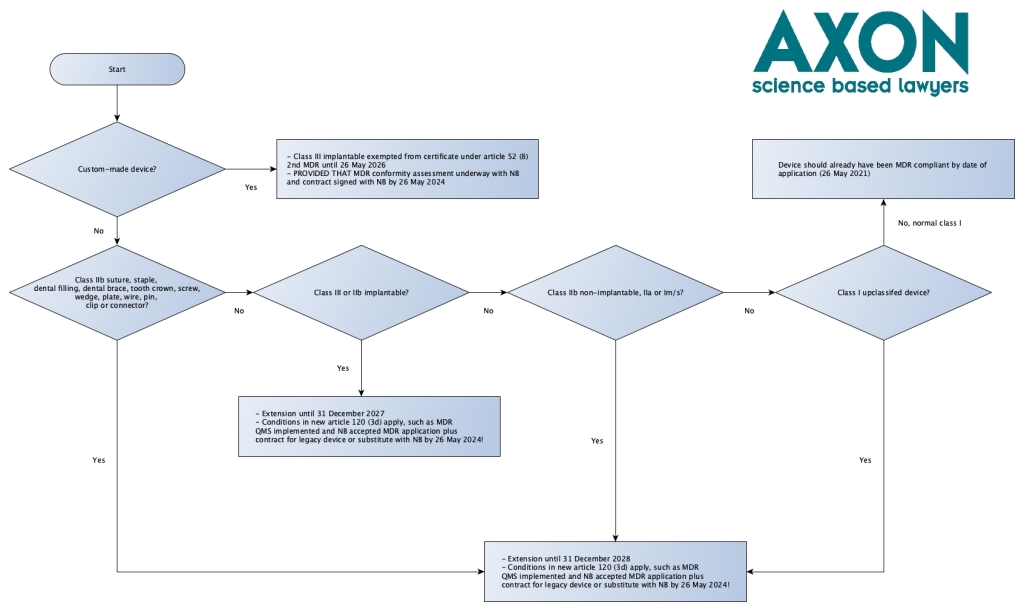Sometimes you come across cases that violate Mandalorian Creed: “One does not speak unless one knows.”.
This happened to me last week when I read the Dutch Supreme Court’s judgment in a case about VAT levied on medical devices, rendered on 8 September.
Some background: in the Netherlands we like to use taxes as a means to organise society by providing (dis)incentives through taxes. This is why we now have a tax system that is so complex that nobody understands it anymore and the tax service cannot even implement it reliably (this not made up or a personal opinion by the way). Also, for many of the tax (dis)incentives it is absolutely unclear if they achieve the intended effect because our government hates to do impact assessments for things that look nice politically.
Background
So what happened in this case? In the Netherlands we have two VAT (turnover tax) brackets: high (21%) and low (9%). This is great for policy by politicians, because you can move products and services around between these brackets. You can subsidize certain professions or products to look like you are really helping people, which Dutch politicians liek to do, especially with elections in sight.
For historical reasons medicines are in the low VAT bracket and medical devices are in the high VAT bracket. Since the Netherlands is a state of law, we have legal principles underlying taxes, such as the principle of fiscal neutrality (which is also an EU tax principle by the way). That means (in short, because the application is actually complicated legal voodoo that you can use in anyway as is opportune for tax collection as we will see in this case as well, as I’ve blogged about before on this blog in relation to customs law characterisation of products) that products that serve the same purpose for a consumer should be taxed in the same way, because that would be fair and non-arbitrary.
A medical devices company with a substance based device that does the same as some medicines decided to challenge the high VAT rate applied to its products based on violation of the principle of tax neutrality and then ran into what I can only qualify as an impressive exercise in regulatory bias based on prejudices about medical devices regulation, without empirical basis.
No empirical basis? It is actually confirmed in the judgement where it says that the lower courts could suffice by conceiving an abstract idea of how the consumer chooses between interchangable medicines and medical devices that are indicated for the same treatment rather than check how consumers really think by means of market research.
I must concede here that the European Court’s case law provides that a national court is not obliged to order market research under all circumstances when having to decide how the decision pattern of the average consumer works in a given factual context. However, the European Court, wise as it is, also holds that it may be very prudent to do market research to support a national court decision on this point. To which I will add: and it would be nice if the court also takes the trouble to be properly briefed about how medical devices regulation actually works. Both of these things did not happen in this case and then the results can be case law that does not look convincing at all and gives a strong whiff of regulatory bias between the medicines and medical devices regulatory frameworks.
More detail: the lower court landed on the ruling that the products concerned (over the counter medicines and over the counter devices for the same therapeutic indication) were not similar for consumers because:
- the regulatory regime is different; and
- the use of the product is different.
Let’s how the Supreme Court paraphrases this (this is my unoffical translation from the judgment in Dutch):
“3.4 The Court took as its starting point that the principle of fiscal neutrality applicable to the levying of turnover tax precludes the different treatment for turnover tax purposes of supplies of goods that are similar from the point of view of the average consumer. Artificial distinctions based on insignificant differences are to be avoided. In the Court’s view, the non-prescription registered medicines to which the interested party compares are not similar to the S products. Not only do the legal framework and legal regime under which each of these groups of products falls differ, but also their use is not similar. Here, the Court took into account that suppliers of registered medicines, including those that may be supplied to consumers without a prescription from a general practitioner or medical specialist, have to comply with different and more stringent requirements and undergo a more extensive procedure in terms of market authorisation, quality, efficacy and risks of those products and informing consumers about them, than that which the interested party has to comply with as a supplier of the products. The supervision of (non-prescription) medicines is also stricter. Monitoring the quality of medicines on the market is an ongoing process. In contrast, the Health and Youth Inspectorate checks only by means of a random sample whether medical devices indeed fall under the low risk class claimed by the manufacturer and meet the other requirements, the Court said.
3.5 Although the Court of Appeal considers it plausible that the S-products and the non-prescription medicines referred to by the interested party have similar properties as regards the treatment of the skin conditions referred to above in 2.1, in the Court of Appeal’s opinion, the interested party has not made it plausible that the differences described above in 3.4 do not play a role for the average consumer. The Court of Appeal considers it plausible that for the average consumer the quality and control guarantees surrounding registered medicines may be a decisive factor when making a choice between a registered medicine and (one of) the S-products. For the average consumer, the registration of a product as a medicinal product constitutes an important indication of the reliability of its efficacy and safety, which is underlined by the legally required comprehensive package leaflet containing relevant information on the efficacy, side effects and any other risks associated with the use of the medicinal product, the Court said. Since the S-products do not meet the requirements set out in the Medicines Act, nor are those products presented to customers as registered medicines, the Court does not consider it plausible that the S-products are nevertheless interchangeable with the non-prescription medicines referred to by the interested party in the eyes of the average consumer. The fact that the S-products must comply with the requirements of Directive 93/42/EEC does not make them medicinal products within the meaning of the Medicines Act, the Court continued.”
X / de STAATSSECRETARIS VAN FINANCIËN, Supreme Court 8 September 2023, ECLI:NL:HR:2023:1124
Mind you, this reasoning has not been based on factual research about what consumers actually think. This was conceived by the lower court in abstracto without the court thinking that it might be good to back this up with some facts. The Supreme Court upheld the lower court’s judgment on all points.
What does this mean? Apparently according to the Supreme Court:
- Consumers (apparently) attach decisive importance to the regulatory supervision of similar products, and will choose the one regulated more ‘extensively’
- Medicines in general but also over the counter medicines are subject to different and more stringent requirements and undergo a more extensive procedure in terms of market authorisation, quality, efficacy and risks of those products and informing consumers about them
- For the average consumer, the registration of a product as a medicinal product constitutes an important indication of the reliability of its efficacy and safety, which is underlined by the legally required comprehensive package leaflet containing relevant information on the efficacy, side effects and any other risks associated with the use of the medicinal product
- Complying with medical devices law does not make your product a medicinal product so it’s less attractive to consumers and therefore not interchangeable for tax purposes and can therefore be taxed differently.
Let’s unpack this.
Do consumers attach importance to the regulatory regime?
I do not believe for one single second that consumers attach importance to the regulatory framework under which a product is regulated. I really don’t. Rather, I think that consumers attach importance to the products being safe and effictive, regardless of the regulatory framework. This is the basis of EU product law for healthcare products: ensure a high level of public health and a high level of consumer protection. Medical devices regulation really is not intended by the EU legislator to do any concessions on these points compared to other legislation for other products. Rather, different products are subjec to different regulatory approaches, each proportionate and suited to the products in scope.
If it were true that the regulatory approval system of any product would decisively matter to consumers, this would lead to some truly bizarre situations. For example: consumers would always choose birth control pills (medicine) over condoms (medical device) for anti-conception purposes because the pill is a medicine and therefore obviously superior. Can you see how absurd that would be? I can tell you that I’m really glad that my own young adult children think about these things differently than the courts. More in general (if this theory of regulatory approval regime is a decisive factor in choosing) consumers would prefer to travel by airplane over travel by train, because airplane type approval is more ‘extensive’ regulation than train type approval and of course: consumers are deemed aware of this. People in the Netherlands would abandon their bicycles en masse in favor of cars because motor vehicles are subject to the stricter regime of type approval whereas bicycles only fall under the rather low end general product safety requirements (plus a batteries and EMC/LVD top up for e-bikes, which should have people preferring e-bikes over normal bikes because they are regulated more strictly).
If the court would have taken the trouble to do a descente (technical procedural law term meaning that the court leaves the court building to go look at a real thing happening in real life) to the real world and visited a drug store (where they sell the products concerned in this case) instead of dreaming up this theory in the privacy of its chambers, ask yourself if it would be possible that the court would have witnessed the following conversion:
[enter customer while court members browsing products are trying to look unsuspicious in various places in the drug store]
Customer: “Good morning, do you have something for [skin problem]?”
Sales person: “Good morning sir, we sure do. Would you come with me please?”
They walk to a shelf where a lot of colorful boxes with lots of letters on them are stacked under a big sign on the ceiling saying “SKIN”.
Sales person takes two boxes from the shelf: “Here sir, we have product [A] and product [B].”
These two products happen to be both creams, one a medical device and the other a medicine because they have a different mode of action.
Customer looks at the colorful boxes: “Which one do you recommend?”
Sales person: “Well, they both work for your skin problem. They have a bit of a neutral scent. Customers seem to be happy with either of them. But we sell most of these. [indicates medical device box]”
Customer: “In that case I want the medicine one.”
Sales person: “Oh?”
Customer: “Because the approval system is stricter and it has better post market follow up.”
Customer takes boxes from the sales person examines boxes by turning them in all directions.
Customer: “Yes, look, here. Here is the CE mark for the medical device product.”
[customer grimaces disapprovingly]
Customer continues: “And here is the RVG number for the medicinal product. So I’m taking that one. You can put the medical device back. Nobody wants that, with its substandard regulatory approval system. I’m surprised you even bother trying to sell this stuff. Nobody wants medical devices if they can get medicines for the same thing.”
Sales person: “Alright sir. Would you like me to give you more information about the medicinal product? Like about possible side effects?”
Consumer: “No thanks, I’ve got my medicinal product – that’s all I’m interested in. Nothing can top that and I’m sure these products are the best and that side effects for me are properly risk managed. I am of course going to read the patient leaflet from top to bottom. Can I pay please?”
Sounds absurd? Of course I’ve added some poetic license to show in this example dialogue how absurd the Supreme Court’s argument about assumed customer preference is, but essentially it reflects the argument 100%.
I hope you agree by now that this line of argumentation is not that realistic if not supported by facts about what consumers really think and what properties of products with similar intended use really matter to them. I am willing to bet a very good bottle of wine that the regulatory regime is utterly irrelevant to the average consumer. The average consumer expects something that is safe and effective, and will assume that any rules applied to any product publicly available will produce that outcome.
The most cynical point about this case is that the Appelate Court ruled that, when deciding whether product are similar for fiscal neutrality purposes, ‘artificial distinctions and insignificant differences are to be avoided’ (“Daarbij moeten kunstmatige onderscheiden op basis van onbeduidende verschillen worden vermeden.” – Supreme Court judgment section 3.4).
Misunderstandings
The judgment contains – in my modest opinion – some misunderstandings about medical devices law as it applies currently (or rather, already does since 26 May 2021) with the MDR. The Supreme Court and lower courts mention a number of determining characteristics that make medicines regulation apparently more attractive to consumers:
- “more extensive procedure in terms of market authorisation, quality, efficacy and risks of those products and informing consumers about them, than that which the interested party has to comply with as a supplier of the products”
- “The supervision of (non-prescription) medicines is also stricter. Monitoring the quality of medicines on the market is an ongoing process.”
- “In contrast, the Health and Youth Inspectorate checks only by means of a random sample whether medical devices indeed fall under the low risk class claimed by the manufacturer and meet the other requirements.”
Let’s address these three points one by one.
More extensive procedure?
If you compare apples and oranges, a comparison never produces a relevant outcome. That’s basic logic. As I’ve shown with the examples above, the comparison between regulatory regimes for different products serves no purpose. It makes no sense to measure a product by a yardstick that doesn’t apply to it. A nuclear plant has a more extensive approval process than the solar panels on the roof of my house. Yet they serve the exact same purpose for me: produce electricity. And I am happy that each is controlled by a regulatory regime appropriate to it, ensuring that it is safe and effective for its purpose. But it does not mean that I favor nuclear generated electricity because the regulatory regime for nuclear plants is more extensive.
In the cases where borderline products are concerned (typically the category of substance based devices under rule 21 of Annex VIII MDR), it is important to note that under the MDR the conformity assessment procedure has become a lot more complex and now also includes an assessment of the quality of the substance by the medicinal products authorities, which leads to the interresting situation that with this the Supreme Court’s comparison argument is even less valid, because the same authortiy looks at substance quality of both groups of products (medicines and substance based devices). It means that if this case would be re-litigated for a substance based device under the MDR, the Supreme Court would need to come up with a new argument.
Stricter PMS and supervision?
Same point as previous, but worth to repeat verbatim: if you compare apples and oranges, a comparison never produces a relevant outcome. That’s basic logic. You learn this in basic math. But, tax is voodoo with different logic apparently. In tax law you can say that a fish is less evolved than a monkey because it doesn’t climb trees and that people therefore like monkeys better.
Apart from this, there is the underlying assumption that PMS and supervision of medical devices is so much more inferior that this would be (a) known the average consumer and (b) relevant to the average consumer and (c) relevant in the overall quality of supervision.
Since 26 May 2021 the MDR has added – for all devices in the market, including the legacy ones, and even the class I devices – the MDR PMS requirements which are very elaborate and apply to the entire life cycle of the device, even for class I self certified devices.
The Supreme Court would have done well to for example check with the competent authority for pharmacovilance and medical devices PMS and vigilance (IGJ) about what they think. If the IGJ would have been asked on the spot which one is better, I think that the IGJ would have said that both serve their respective purpose for the products in scope as well as they can.
Competent authority only performs sample checks?
This is just not true. Both under the MDD and MDR, and even for class I devices, the manufacturer has to monitor how the device is doing in the market by means of vigilance monitoring and report to the authorities any incidents that qualify as reportable. In case of any device above class I the device is (and was under the MDD too) subject to surveillance by the notified body that issued the CE certificate that is mandatory for classes IIa and up, as well as for sterile devices and devices with a measuring function (and under the MDR reusable surgical instruments, but these are usually not sold over the counter to consumers so not relevant in this picutre).
This means that the Supreme Court has either been misinformed on this point or misunderstood the argumentation that parties provided. In either case, all the more reason to revisit this.
Community loyalty?
The judgment is also, in my view, quite presumptuous about the comparative quality of (in both cases) European legislation. It suggests that medical devices are supervised ‘worse’ and that this is also obvious to consumers to the point that it determines their preference.
I would assume that the task of a Supreme Court is not to make value judgements about the comparative quality of different sets of EU legislation for different products, but rather decide on issues of law (what regime applies) and not of preference (what regime is better).
The respective products are monitored differently because they are very different products that work differently and are each subject to regulatory controls that the EU legislator has deemed effective and proportional for the products concerned.
In my opinion this presumptuous second guessing is at odds with the principle of Community loyalty of EU member states. The Supreme Court might have asked the EU Court if fundamentals of EU law even allow making this kind of distinction for the purpose of VAT law (which, also, is EU law by the way).
Anyways
As stated at the beginning of this post, I think that this case would have been more appropriately decided under Mandalorian Creed. The Supreme Court might get some inspiration from the Mandalorians, a humble warrior caste from the Star Wars universe that is low on value judgments because the Mandalorians know that knowledge is by definition empirical, i.e. fact based. Because this is the way.
As my examples show, the abstract argumentation used is spectacularly unhelpful in this case because it is not convincing, compares apples and oranges and looks arbitrary.
As much as everyone likes to pay taxes, me included, a credible application of the principle of neutrality in taxes does help for a good legal basis for the tax measure concerned. Making a hypothetical distinction between regulatory approval systems and attributing that to the average consumer without any factual backup does not serve that purpose of a solid legal basis. It sounds abritrary, which is not a lawful basis for imposing tax to begin with. We need a substantiation that at least sounds somewhat rational and is preferably tax based.
I hope that another company will have the guts and stamina to re-litigate this case with explicit reference to the MDR (because the present case only looked at the MDD) and the need to support this with some hard facts. That should lead to a different outcome, especially for devices that have gone through MDR conformity assessment. If that company needs someone for the devices and medicines argumentation, please count me in because the good part about mistakes in (case) law is that they can always be corrected. As the Mandalorians would say: this is the way.













